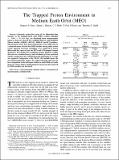| dc.contributor.author | Huston, Stuart L. | |
| dc.contributor.author | Roth, C. J. | |
| dc.contributor.author | O’Brien, T. Paul | |
| dc.contributor.author | Guild, Timothy B. | |
| dc.contributor.author | Ginet, Gregory P. | |
| dc.date.accessioned | 2012-02-03T19:14:38Z | |
| dc.date.available | 2012-02-03T19:14:38Z | |
| dc.date.issued | 2010-09 | |
| dc.date.submitted | 2010-09 | |
| dc.identifier.issn | 0018-9499 | |
| dc.identifier.issn | 1558-1578 | |
| dc.identifier.other | INSPEC Accession Number: 11693026 | |
| dc.identifier.uri | http://hdl.handle.net/1721.1/69028 | |
| dc.description.abstract | Energetic proton flux maps of the differential flux intensity in the medium-Earth orbit (MEO) regime (altitudes ~ 7000-15,000 km) are developed from measurements taken by detectors aboard the Combined Release and Radiation Effects Satellite (CRRES), HEO-F1, HEO-F3 and ICO satellites. Measurement errors have been estimated by cross-calibrating to a standard sensor aboard the GOES satellite during solar proton events. Spectral inversion techniques were employed to derive differential flux spectra from the HEO and ICO integral channel dosimeters. Two methods for combining the four different satellite data sets on a standard energy and coordinate grid are presented and the ramifications due to limited spatial and temporal coverage are explored. Comparison to the NASA AP-8 models shows the new model median flux maps to be of approximately equivalent or lower magnitude in the slot region while new model 95th percentile maps are always higher. Implications for the proton dose received by MEO satellites are discussed. | en_US |
| dc.description.sponsorship | United States. Air Force (Contract FA8721-10-C-0007) | en_US |
| dc.language.iso | en_US | |
| dc.publisher | Institute of Electrical and Electronics Engineers (IEEE) | en_US |
| dc.relation.isversionof | http://dx.doi.org/10.1109/tns.2010.2085086 | en_US |
| dc.rights | Article is made available in accordance with the publisher's policy and may be subject to US copyright law. Please refer to the publisher's site for terms of use. | en_US |
| dc.source | IEEE | en_US |
| dc.title | The Trapped Proton Environment in Medium Earth Orbit (MEO) | en_US |
| dc.type | Article | en_US |
| dc.identifier.citation | Ginet, Gregory P. et al. “The Trapped Proton Environment in Medium Earth Orbit (MEO).” IEEE Transactions on Nuclear Science (2010): n. pag. Web. 3 Feb. 2012. © 2010 Institute of Electrical and Electronics Engineers | en_US |
| dc.contributor.department | Lincoln Laboratory | en_US |
| dc.contributor.approver | Ginet, Gregory P. | |
| dc.contributor.mitauthor | Ginet, Gregory P. | |
| dc.relation.journal | IEEE Transactions on Nuclear Science | en_US |
| dc.eprint.version | Final published version | en_US |
| dc.type.uri | http://purl.org/eprint/type/JournalArticle | en_US |
| eprint.status | http://purl.org/eprint/status/PeerReviewed | en_US |
| dspace.orderedauthors | Ginet, Gregory P.; Huston, Stuart L.; Roth, C. J.; O'Brien, T. Paul; Guild, Timothy B. | en |
| mit.license | PUBLISHER_POLICY | en_US |
| mit.metadata.status | Complete | |
